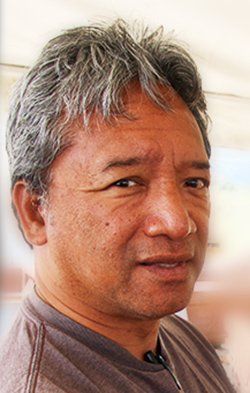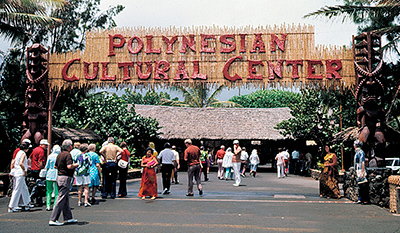Fun Fact: Tiki is a Maori word; ki’i is the Hawaiian equivalent, but we’ll stick with the Maori version because it’s so prevalent. Also, the plural form of Polynesian nouns in their respective languages is not made by adding S — some writers won’t even add an S when the Polynesian word is used in English, but we will utilize them for the comfort of our mainland readers:

As guests stroll from the Polynesian Cultural Center’s new Hukilau Marketplace into the village area, they now pass through an impressive gateway arch that is over 30 feet tall, set-off by the heroic sized statue of Laie-born Hamana Kalili forever waving his world-famous Hawaiian shaka sign, and two more recently installed gigantic tikis — the latter thanks to the creative talents of PCC master carver Kawika Eskaran.

If that name sounds familiar, it’s because we featured Eskaran in a story in our last enewsletter about the PCC’s Maori waka taua or war canoe (click here). His expert skills are widely utilized throughout the Polynesian Cultural Center, and in this issue he gives us the inside scoop on how he — along with Jared Pere, Tuione Pulotu and others — created our newest, iconic tikis.
“These tikis are very unique, and they were very difficult to do,” Eskaran said. “They stand 26-feet tall on the pedestals and they are about 5 feet wide. They are similar, but not identical. For example, they both have wide mouths, big teeth and are rather angry looking, but the headdresses and facial features are different.”
“We wanted them to look as though they were from the same family. We’ve created them in more of a Kona-style: That’s a classic style that would have been found on the island of Hawaii in the Kona area, especially around Honaunau, that reflected what was in Hawaii when the first European explorers came.”
Surprisingly, Eskaran estimated each finished tiki only weighs approximately 400 pounds. That’s because both are made from an industrial-grade of high-density foam — not wood, as their ancient counterparts would have been.
Eskaran explained he loves to work with wood, but appropriately sized pieces cost a lot more money and are often hard to obtain now days. “For example, a 4-by-4-by-8-foot block of foam costs a little under $400, and we needed three-each of those to make one tiki. To get a log that same size, if we could find one, would have cost thousands of dollars.”
Ironically, Eskaran also noted that “although carving wood would have been faster, the resulting tikis wouldn’t last as long,” what with exposure to Hawaii’s moist, salty breezes, moisture and insects. He said if he had used chainsaws to rough shape the wood, “I could have finished the tikis in less than two weeks. With sculpting the foam, it took months.”
Eskaran explained why. Where he would use chainsaws of various sizes and chisels on wood, he typically uses hot wires, reciprocating saws, knives, razor blades, grinders and other tools to sculpt the foam. He said this part is actually a little easier than carving wood; but…
“Then, when we had shaped each one, we actually cut each tiki in half, hollowed out an area where metal piping provides structural integrity, bent and welded the piping, and then everything was placed together again and refoamed.”

The new welcoming arch is similar to the main entrance that welcomed PCC guests from the late 1960s to 1976.
The exteriors of the tikis were also coated and painted, and a strong anchoring system was added that mounted and bolted the tikis to their cement pedestals. “Those tikis can’t be blowing around in high winds,” he added.
Eskaran valued the finished tikis at between $100,000 to $200,000 each, and said “they are unrivaled in the state of Hawaii in terms of size and their durability. They’ll last forever, as long as we maintain their exterior coating.”
In addition to his carving duties at PCC, Eskaran also captains the Iosepa, the ocrean-going 57-foot twin-hulled traditional Hawaiian sailing canoe in PCC’s Hawaiian Village, and teaches the associated sailing classes.
Story by Mike Foley

Mike Foley, who has worked off-and-on
at the Polynesian Cultural Center since
1968, has been a full-time freelance
writer and digital media specialist since
2002, and had a long career in marketing
communications and PR before that. He
learned to speak fluent Samoan as a
Mormon missionary before moving to Laie
in 1967 — still does, and he has traveled
extensively over the years throughout
Polynesia and other Pacific islands. Foley
is mostly retired now, but continues to
contribute to various PCC and other media.

Recent Comments